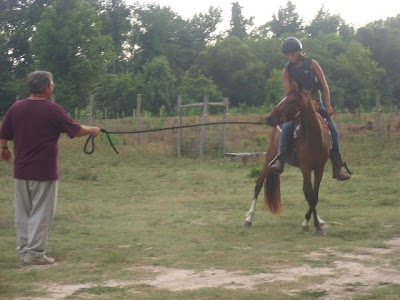
The Center for America's First Horse
Stephanie Lockhart, Founder/Director
P.O. Box 274
Morrisville, Vermont 05661
505-340-8376 (cell)
The Center for America’s First Horse (CFAFH) is located on 72 donated acres in Johnson, Vermont. Our mission is to provide relationship experiences with rare Colonial Spanish horses to enrich the lives of people of all ages and financial circumstances. We are dedicated to conserving this historic breed through education and public awareness.
The Colonial Spanish horse, like the buffalo, has served many of America's native tribes for centuries, and is now close to extinction. Today, the value of these horses goes way beyond their epic history, intelligence, and natural beauty. They are the true teachers. Our programs focus on education and exploration of the horse/human relationship using natural horsemanship philosophy and techniques. We currently have 12 Colonial Spanish horses at the facility, the largest and most diverse group of this breed in the northeast.
The CFAFH directly serves the Lamoille and neighboring counties of northern Vermont. We work closely with local schools to provide students volunteer opportunities and internships. In addition, the CFAFH provides horse experiences that are healing in nature to youth in foster care and those considered "at-risk". Educational tours of the varied groups of Colonial Spanish horses which reside at our facility are given to 4-H groups, horse clubs and other organizations as well as individual visitors to our region.
In keeping with our mission statement of conservation through public awareness, we travel with our horses throughout the year to equine expo's, fairs, horse shows, schools, and other public venues. Our presentations have taken us to New Mexico, Indiana, Massachusetts, New York and throughout Vermont.
This year we anticipate attending Dressage at Devon in Pennsylvania. Founder and director, Stephanie Lockhart, travels to Switzerland as a clinician of natural horsemanship and to promote Colonial Spanish horses abroad. Media coverage has included articles in Vermont Life magazine, Horseman's Yankee Pedlar, New Mexico's Horseman's Voice magazine and coverage in numerous newspapers.
Impressively Better, (Oscar), the equine movie star from the Disney movie HIDALGO resides at CFAFH and is owned by Lockhart's teenage daughter. "Oscar" draws attention to the cause and travels alongside the ambassador horses from CFAFH. His popularity and public image makes him an integral part of our efforts.
It is estimated that in one year of promotion the Colonial Spanish horses from CFAFH are seen by 100,000 people through different media sources and personal introduction. Of that number, 70% are horse owners, 20% horse enthusiasts, 10% the general public.
Currently, CFAFH is applying for 501(c)(3) non profit status and expect our acceptance in 2011. Our primary source of revenue is private donations and fundraising. Donations of goods and services have allowed us to meet only our immediate needs.
If you would like to become a member of The Center at the levels of $25, $50, or $100 please contact us for a membership form. We accept credit cards over the phone, or you can mail your contribution to: The Center for America's First Horse, PO Box 274, Morrisville, VT, 05661.
The Center for America's First Horse
Calendar of Events:
April 24-25 Everything Equine, Essex Jct. Vermont
April 27- May 11 Natural Horsemanship clinics, Switzerland
May 22 Natural Horsemanship Clinic @ CFAFH
May 28-29 Northeast Equine Expo, Belmont Race Track, NY
June 2 Johnson State College-Demonstration Johnson, VT
June 19 Natural Horsemanship Clinic@ CFAFH
July 17 Natural Horsemanship clinic, @ CFAFH
July 23-25 Johnson Field Days, Johnson, VT
August 7 Equine and Arts Festival CFAFH fundraising event, Johnson, VT
August 15 Route 15 Summer Festival, Lamoille County, VT
August 21 Natural Horsemanship clinic@ CFAFH
September 4 Johnson State College- Presentation Johnson, VT
September 19 Shelburne Farms Harvest Festival Shelburne, VT
September 23-26 Dressage at Devon Breed Show
October- Natural Horsemanship Clinics- Switzerland
Website:
www.centerforamericasfirsthorse.org
Visit us on Youtube:
http://www.youtube.com/watch?v=-g3ri4cHrCo
Facebook:
http://www.facebook.com/home.php?#!/pages/Center-for-Americas-First-Horse/10150104999335094?ref=search&sid=690473365.2377754074..1
Blog:
www.centerforamericasfirsthorse.blogspot.com
Immediate Need:
Our current trailer has been diagnosed with mechanical issues that make it unsafe to haul horses. The expense of repairs far exceeds the worth of the trailer. We are seeking a:
Sponsor to donate a horse trailer to the The Center for America's First Horse for one year.
Sponsor to donate $8,000 to purchase a trailer for The Center For America's First Horse.
Sponsor will be recognized in all advertisement paid by CFAFH, have logo and name on trailer, banner displayed prominently at CFAFH, and at all CFAFH events and venues attended, name and logo listed as SPONSOR on our web site, facebook fan page, blog, and any other social network sites that are appropriate. CFAFH will work with the sponsor to promote their business. Sponsor has the right to use photo's of our ambassador horses as publicity for their company.



.JPG)


















.jpg)

